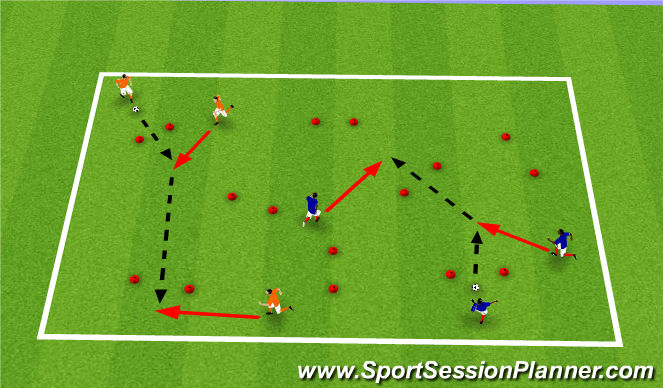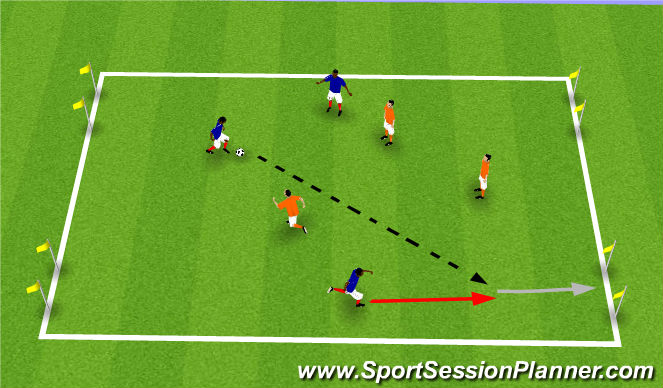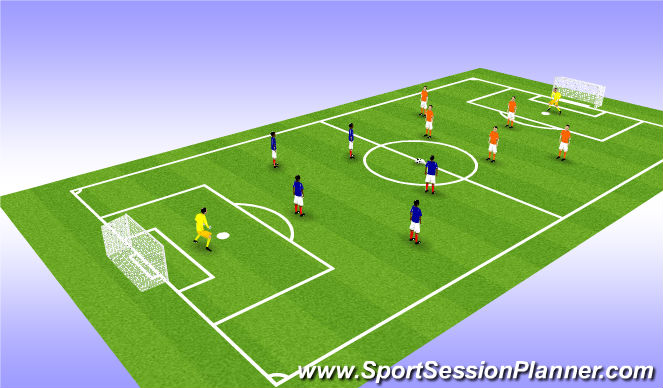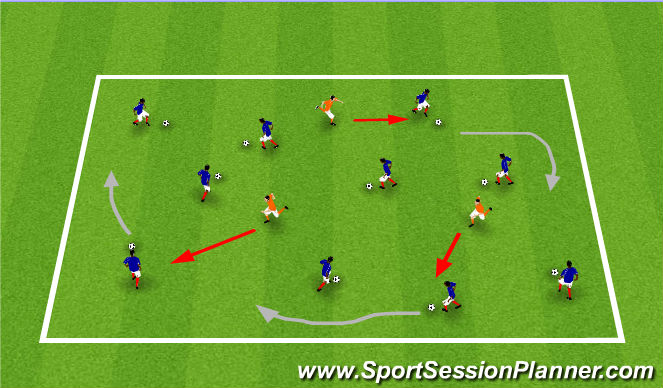Football/Soccer Session (Moderate): Academy W1S1 - U10 Short Distance Passing – Push Pass Technique

Profile Summary

| Name: | David Knapp |
|---|---|
| City: | Asheville |
| Country: | United States of America |
| Membership: | Adult Member |
| Sport: | Football/Soccer |
Description
U10 Short Distance Passing

See the guidance at the top of this page to understand why you are not seeing interactive Football/Soccer images.

Paint the Field w/ Progression to Gates (25 mins)
3 players 1 ball. As a group of 3 players pretend that the field is a piece of paper and they must pass the ball (their paint brush) to cover the entire page. If you don't have perfect groups of three you can have a few groups of two, but do NOT use groups of four at this age.
Progress to Gates: with the same groups players now try to pass the ball through as many gates as possible. Make gates in various sizes, directions, and colors. Gradually provide more challenges for the players.
Coaching Points:
•How can your pass make your partner better?
•What part of your foot should you use to be accurate?
•What should your non-kicking foot point towards?

See the guidance at the top of this page to understand why you are not seeing interactive Football/Soccer images.

3v3 or 2v2 to four small goals/gates (25 mins)
Set up two fields so no kids are sitting out. The field should be approximately 30 yards long x 25 yards wide with two small goals or gates on each end line. Players compete in a 2v2 or 3v3 setting and score a point by passing or dribbling the ball through the goals/gates. Rotate the teams.
Coaching Points:
- What does a good pass look like?
- Why was that defender able to pick off that pass?
- How can your pass make your teammate better?

See the guidance at the top of this page to understand why you are not seeing interactive Football/Soccer images.

Scrimmage 6v6 (15 mins)
Facilitate the game and help with positions, positioning, and game format. Facilitate a basic scrimmage with a goalkeeper and five field players. Allow the kids to “PLAY” but give guidance when necessary. Use a “coaching in the game” approach to emphasize the topics from this week’s training. Be sure to use the labeled names for the positions!
Coaching Points:
- Did that pass make your teammate better?
- What should your body and feet look like when making a good pass?
- What happens if I hit the ball too hard? Too Soft?









 Play animation
Play animation Play step-by-step
Play step-by-step Repeat (toggle)
Repeat (toggle) Full Screen
Full Screen Pause
Pause Stop
Stop
Freeze Tag (10 mins)
There are “Dribblers” and “Taggers”. In a group of 12-13 kids, you’ll have about 10 dribblers and 2-3 taggers. On the coach’s signal the taggers are released to try and tag dribblers who obviously try to stay away from the taggers. Taggers do NOT have a ball, Dribblers do have a ball at their feet and must always keep it within touching distance. If a dribbler’s ball goes out of bounds, they lose control of their ball, or a tagger tags them the dribbler becomes FROZEN. A Frozen dribbler stays where they were tagged, holds the ball above their head, and keeps their feet shoulder width apart. A fellow dribbler can UN-Freeze players who are frozen by pushing their ball between the frozen player’s legs. If the taggers get everyone frozen they win. If the dribblers can go for two minutes without everyone getting frozen the dribblers win. Rotate the taggers for the next game. Play two or three rounds depending how long each round takes.
Coaching Points:
•Heal down, toe up, ankle locked foot position (check mark)
•Hips and non-kicking foot pointed in direction of target
•Watch your foot strike through center of the ball
•How hard or soft to strike the ball (proper weight)